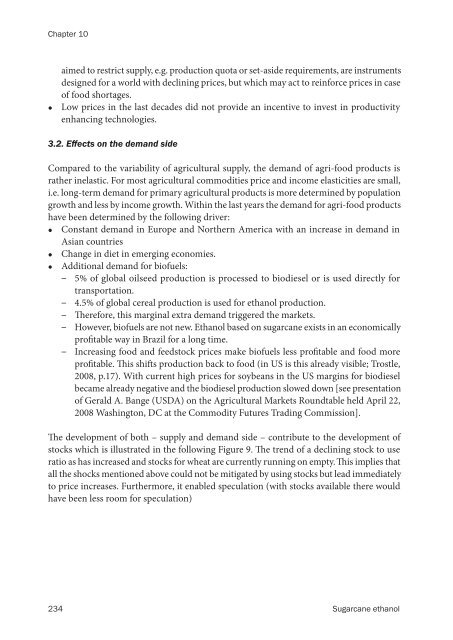Sugarcane ethanol: Contributions to climate change - BAFF
Sugarcane ethanol: Contributions to climate change - BAFF
Sugarcane ethanol: Contributions to climate change - BAFF
You also want an ePaper? Increase the reach of your titles
YUMPU automatically turns print PDFs into web optimized ePapers that Google loves.
Chapter 10<br />
•<br />
aimed <strong>to</strong> restrict supply, e.g. production quota or set-aside requirements, are instruments<br />
designed for a world with declining prices, but which may act <strong>to</strong> reinforce prices in case<br />
of food shortages.<br />
Low prices in the last decades did not provide an incentive <strong>to</strong> invest in productivity<br />
enhancing technologies.<br />
3.2. Effects on the demand side<br />
Compared <strong>to</strong> the variability of agricultural supply, the demand of agri-food products is<br />
rather inelastic. For most agricultural commodities price and income elasticities are small,<br />
i.e. long-term demand for primary agricultural products is more determined by population<br />
growth and less by income growth. Within the last years the demand for agri-food products<br />
have been determined by the following driver:<br />
• Constant demand in Europe and Northern America with an increase in demand in<br />
Asian countries<br />
• Change in diet in emerging economies.<br />
• Additional demand for biofuels:<br />
– 5% of global oilseed production is processed <strong>to</strong> biodiesel or is used directly for<br />
transportation.<br />
– 4.5% of global cereal production is used for <strong>ethanol</strong> production.<br />
– �erefore, this marginal extra demand triggered the markets.<br />
– However, biofuels are not new. Ethanol based on sugarcane exists in an economically<br />
pro�table way in Brazil for a long time.<br />
–<br />
Increasing food and feeds<strong>to</strong>ck prices make biofuels less pro�table and food more<br />
pro�table. �is shi�s production back <strong>to</strong> food (in US is this already visible; Trostle,<br />
2008, p.17). With current high prices for soybeans in the US margins for biodiesel<br />
became already negative and the biodiesel production slowed down [see presentation<br />
of Gerald A. Bange (USDA) on the Agricultural Markets Roundtable held April 22,<br />
2008 Washing<strong>to</strong>n, DC at the Commodity Futures Trading Commission].<br />
�e development of both – supply and demand side – contribute <strong>to</strong> the development of<br />
s<strong>to</strong>cks which is illustrated in the following Figure 9. �e trend of a declining s<strong>to</strong>ck <strong>to</strong> use<br />
ratio as has increased and s<strong>to</strong>cks for wheat are currently running on empty. �is implies that<br />
all the shocks mentioned above could not be mitigated by using s<strong>to</strong>cks but lead immediately<br />
<strong>to</strong> price increases. Furthermore, it enabled speculation (with s<strong>to</strong>cks available there would<br />
have been less room for speculation)<br />
234 <strong>Sugarcane</strong> <strong>ethanol</strong>












